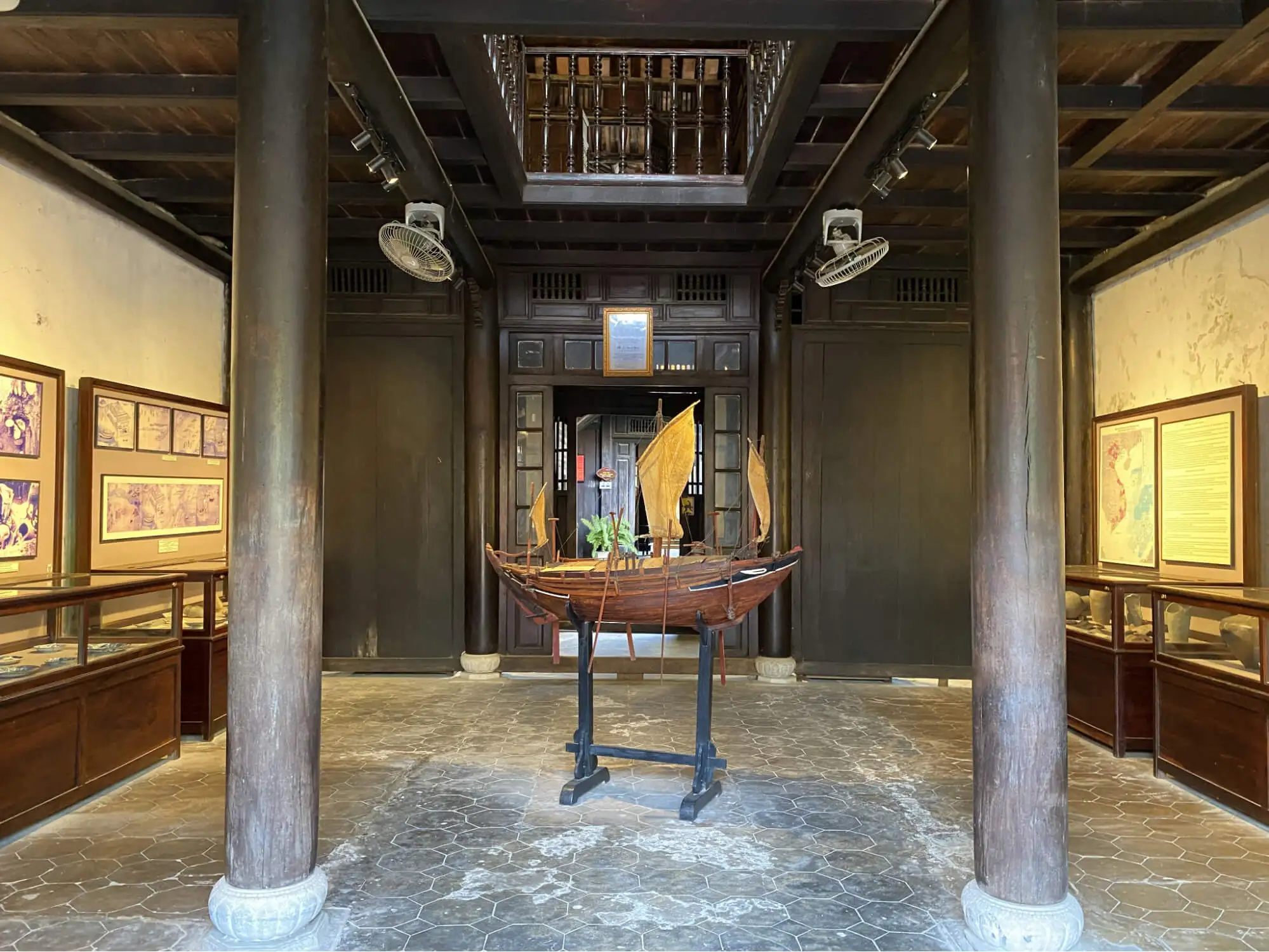Explore the unique artifacts at Museum of Trade Ceramics Hoi An
Hoi An Museum of Trade Ceramics is an attractive destination for those who love ceramic culture and art. Located in the heart of the ancient town, the museum preserves many valuable artifacts, reflecting the formation and development of the ceramic industry through the ages. This is not only a place to explore history but also an opportunity for visitors to admire unique works of art.
About Hoi An Museum of Trade Ceramics
Hoi An Museum of Trade Ceramics is one of the unique destinations, helping visitors to explore and better understand the history of trade and culture of Hoi An. Built in an ancient house with bold traditional architecture, this museum is not only a place to preserve valuable artifacts but also tells the story of the development of Hoi An trading port through the ages.
History of formation and development of Hoi An Museum of Trade Ceramics
In the 16th and 17th centuries, Hoi An emerged as one of the busiest trading ports in Vietnam, attracting a large number of Chinese and Japanese immigrants to trade. In the 17th and 18th centuries, traders from European countries such as Portugal and the Netherlands also flocked to the city, marking a period of strong international trade. Hoi An became an important connection point in the global trade system, contributing to promoting economic and cultural relations between Vietnam and other countries.
The Hoi An Museum of Trade Ceramics is housed in a two-story wooden house built in 1920, which houses valuable artifacts from the period when the trading port developed. After being restored in 1994, the house officially became a museum in 1995, displaying many ceramic artifacts, demonstrating the trade and cultural exchanges between Hoi An and countries around the world.
The museum not only tells the story of the glorious past of Hoi An trading port but also demonstrates the important role of this city in the international ceramic trade system. The artifacts here are evidence of Hoi An’s golden age, when the city was a bustling trading center on the international sea route.

Some highlights of the Museum of Trade Ceramics
The Museum of Trade Ceramics is one of the must-see destinations when visiting Hoi An, especially for those who love history and culture. Located in a two-story ancient house with typical Hoi An architecture, the museum not only attracts visitors by its ancient beauty but also by the profound historical values it preserves.
The museum is divided into many display areas, each area arranges artifacts according to its own theme, to introduce the formation and development process of Hoi An over the centuries. The artifacts here include ceramics, valuable documents, helping visitors understand more about the important role of Hoi An in international trade during the golden age. In particular, the museum is closed on the 15th of every month for preservation and renovation work, ensuring that the artifacts are always best preserved.
The architecture of the museum consists of three main parts: the front yard, the back yard, and the kitchen and resting room in the back. This design not only reflects the lifestyle of the ancient Hoi An people but also creates an open, airy space for visitors to explore. With its ancient beauty and preserved historical values, the Museum of Trade Ceramics is sure to leave a deep impression on anyone who visits.
Read more: Museum of Folk Culture: A Famous Attraction in Hoi An
Opening hours and entrance fees to Hoi An Ceramic Museum

Hoi An Museum of Trade Ceramics is open from 7am to 9pm daily, allowing visitors to freely choose a suitable time to visit. However, it should be noted that on the 15th of each month, the museum will temporarily close for renovation and refurbishment work, in order to best preserve the artifacts and provide a better quality visiting experience.
Regarding ticket prices, the museum applies different prices for domestic and international visitors. Specifically:
- Domestic visitors: 80,000 VND/person/trip.
- Foreign visitors: 120,000 VND/person/trip.
Directions to Hoi An Museum of Trade Ceramics
Hoi An Museum of Trade Ceramics is located right in the city center, very convenient for traveling. With a distance of only about 1 km from the center of the old town, visitors can easily find their way here, although the road has many small turns.
To get to the museum, from the center of Hoi An, you go west towards Cua Dai, then move onto Ba Huyen Thanh Quan street. From here, continue to turn onto Tran Hung Dao street and find the left turn onto Nguyen Hue street. After moving about 150m, you turn right onto Phan Chu Trinh street, then turn left to enter Tran Phu street. The museum is located at 80 Tran Phu, one of the busiest and most famous streets in Hoi An.
What is in Hoi An Museum of Trade Ceramics?
The Hoi An Museum of Trade Ceramics is not just a place to display artifacts but also a journey that takes you back to the past. Here, you will admire unique ceramic works and learn deeply about the traditional pottery craft, from the stages of development to the cultural significance of each product. This is an ideal place for those who want to explore the richness of Vietnam’s cultural heritage.
Discovering ceramics through Hoi An Museum

The Hoi An Museum of Trade Ceramics is not just a place to display artifacts but also a journey that takes you back to the past. Here, you will admire unique ceramic works and learn deeply about the traditional pottery craft, from the stages of development to the cultural significance of each product. This is an ideal place for those who want to explore the richness of Vietnam’s cultural heritage.

Unique ceramic artifacts in the museum
Each artifact at the Museum of Trade Ceramics has its own story, a testament to the development of ceramic art throughout history. This place not only preserves intact artifacts but also displays broken ceramic samples, which creates a unique and attractive feature for the museum.
These items still demonstrate the sophistication in design and manufacturing process, leaving visitors impressed. Moreover, the museum also reflects the skillful craftsmanship of Vietnamese artisans centuries ago, something that many Japanese have learned and applied to their ceramic production.
Cultural value and attraction of museums
Hoi An Museum of Trade Ceramics is not only a place to display artifacts, but also a stop with profound cultural and historical significance. Here, you will find many valuable evidences of the prosperous development period of Hoi An, from which you can feel the irreplaceable cultural value of this heritage.
In particular, the museum provides audio guides in 3 languages (Vietnamese, English and Japanese), helping visitors easily access information. This is truly a valuable experience for every visitor.
Some important notes when visiting the Museum of Trade Ceramics

When deciding to visit the Hoi An Museum of Trade Ceramics, visitors should note the following important points to make the visit more interesting and convenient:
- Buy tickets in advance: The entrance fee is 80,000 VND for domestic visitors and 120,000 VND for foreign visitors. You should prepare cash to buy tickets quickly, avoiding wasting time at the gate.
- Use the tour guide service: For a richer experience, you can rent a tour guide headset for only 20,000 VND/time. This service will help you better understand the artifacts and history of ceramics, making the tour more meaningful.
- Respect the exhibition space: When visiting, remember to keep order and not make noise. The museum is a place to preserve valuable artifacts, so respect for the space and artifacts is essential.
- Take souvenir photos: You can take photos at the museum, but be careful not to affect other visitors. Also, ask in advance if you want to take photos near the artifacts.
- Learn Before You Go: For a more complete experience, learn more about the history and artifacts of ceramics before you visit. This will help you better appreciate the value of the works of art you will see at the museum.
If you are looking for an ideal place to stay when visiting the Hoi An Museum of Trade Ceramics, Bliss Hoi An Beach Resort & Wellness is the perfect choice for you. Located only about 20 km from the museum, Bliss Hoi An is one of the perfect choices for visitors. Just 30 minutes by car, you can easily reach the museum and enjoy the unique cultural space of Hoi An without spending much time traveling.
Bliss Hoi An is not only famous for its location near the Museum of Trade Ceramics but also has many other outstanding advantages. The resort is designed in a modern style but still retains traditional features, creating a cozy and intimate space. The rooms are fully equipped with amenities, from air conditioning to flat screen TVs, helping you have wonderful moments of relaxation.


In addition, Bliss Hoi An also has an outdoor swimming pool and spa area, where you can relax and recharge after your tours. In particular, the staff here are always ready to support and provide information about interesting tourist destinations and activities, helping you enjoy your vacation to the fullest.
Hoi An Museum of Trade Ceramics is not only a tourist attraction but also a journey to learn about the rich culture and history of this land. With a variety of interesting artifacts and activities, this place will definitely bring visitors useful and impressive experiences. Take the time to visit the museum on your trip to Hoi An, to discover the beauty of ceramics and keep memorable memories in the ancient town.








